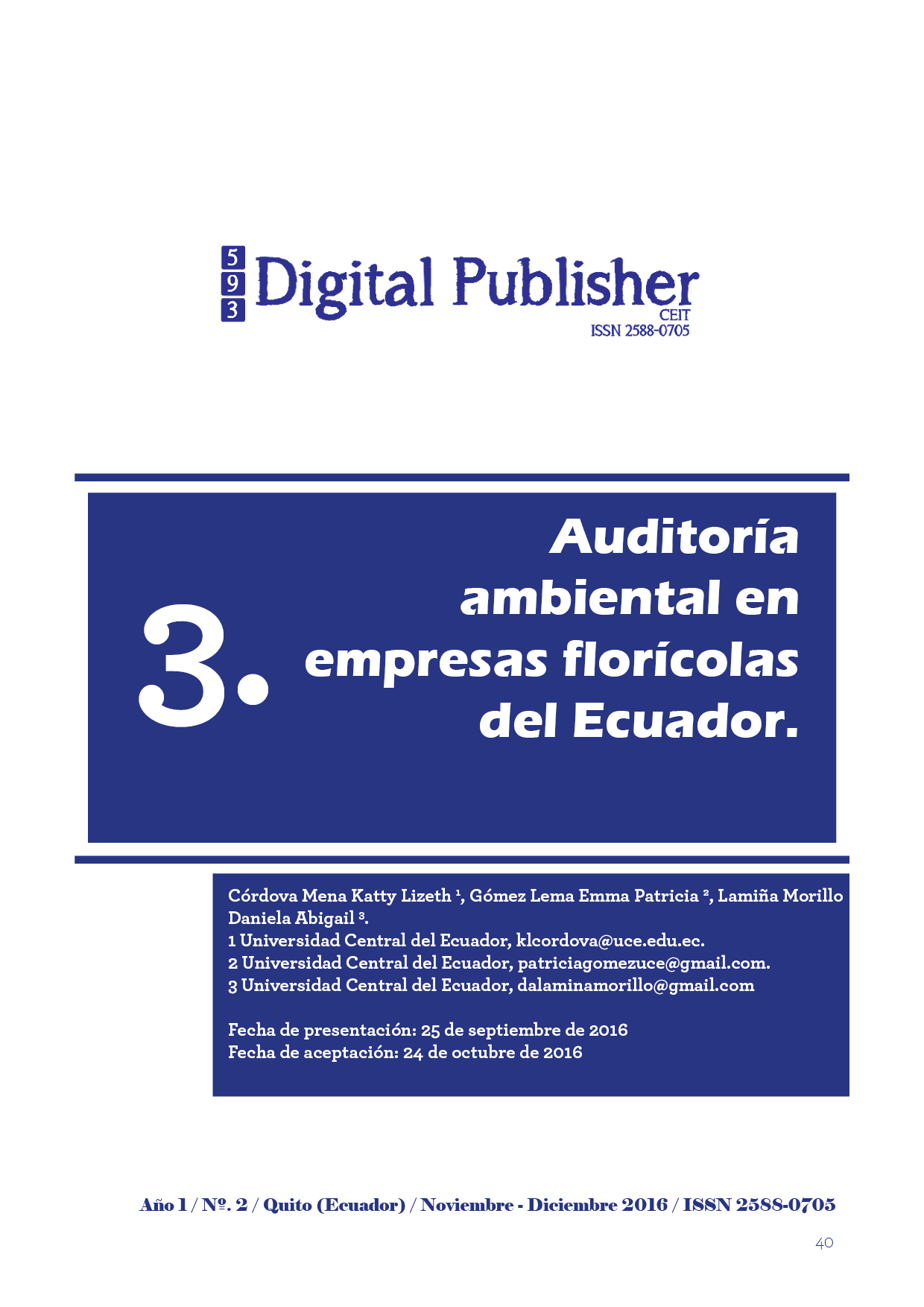Audit environmental in flower companies of Ecuador
Main Article Content
Abstract
The objective of this research work is to evaluate environmental compliance, given that several companies do not give importance to the factors that affect environmental pollution. In order to obtain the information, a number of previous investigations were considered, which determine that the Environmental Audit application. This investigation was of great contribution since several effects were found, either due to non-compliance with environmental regulations or due to lack of knowledge. The floriculture in Ecuador has had an important growth, but it is unknown the problem faced by the floricultural due to the environmental impact generated by the excessive use of pesticides, fungicides and other toxic mixtures that not only affect natural resources, but also of Inhumane way workers who perform their daily activities under sanitary conditions and without protection therefore it is necessary to consider environmental control.
Downloads
Article Details
1. Derechos de autor
Las obras que se publican en 593 Digital Publisher CEIT están sujetas a los siguientes términos:
1.1. 593 Digital Publisher CEIT, conserva los derechos patrimoniales (copyright) de las obras publicadas, favorece y permite la reutilización de las mismas bajo la licencia Licencia Creative Commons 4.0 de Reconocimiento-NoComercial-CompartirIgual 4.0, por lo cual se pueden copiar, usar, difundir, transmitir y exponer públicamente, siempre que:
1.1.a. Se cite la autoría y fuente original de su publicación (revista, editorial, URL).
1.1.b. No se usen para fines comerciales u onerosos.
1.1.c. Se mencione la existencia y especificaciones de esta licencia de uso.
References
BACCIÓN ECOLÓGICA . (2000). Los plaguicidas: una verdad indiscutible. Quito: Acción Ecológica.
Acción Ecológica. (2000). Los plaguicidas: una verdad indiscutible. Obtenido de http://www.docplayer.es/17273521-Caso-1-la-industria-de-las-flores-las-flores-del-mal-lasfloricultoras-y-su-crecimiento-acelerado.html
Cámara Argentina de Feedlot . (s.f.). Obtenido de http://www.feedlot.com.ar/sitio/?page_id=90
CAVE SRL. (octubre de 2013). Planificación de Auditoría Ambiental Auditoría Ambiental Vertedero Municipal de Normandía FASE I. Santa Cruz. Obtenido de http://www.santacruz.gob.bo/archivos/ditcam/auditoria1/AuditoriaAmbientalVertederoNormandiaFase1.pdf
Claudia, V. A. (2009). Guía para Cultivar Flores. En V. A. Claudia, Guía para Cultivar Flores (págs. 21-23). Quito: https://www.linguee.com/spanish-english/translation/los+tallos+de+las+flores.html. Obtenido de http://puceae.puce.edu.ec/efi/index.php/economia-internacional/14-competitividad/177-cultivos-de-rosas-en-el-ecuador
Constitución de la República del Ecuador. (20 de Octubre de 2008). Constitución de la República del Ecuador. Obtenido de https://www.oas.org/juridico/pdfs/mesicic4_ecu_const.pdf
Constitución de la República del Ecuador. (2008). CONSTITUCIÓN DE LA REPÚBLICA DEL ECUADOR. Montecristi.
Contraloria General del Estado. (2013). Guía de Auditoría Ambiental. Obtenido de http://www.contraloria.gob.ec/documentos/normatividad/2%20Guia%20Auditoria%20Ambiental.pdf
Corporación Financiera Nacional. (2017). SECTOR AGRICULTURA, GANADERÍA, SILVICULTURA Y PESCA. Quito.
Correa, D. (22 de julio de 2017). Prezi. Obtenido de Prezi: https://prezi.com/_dl58x-sg39m/auditoria-ambiental/
Educándonos en el Ámbito Económico. (2014). Obtenido de Educándonos en el Ámbito Económico: http://ambitoeconomico.blogspot.com/2013/02/el-sector-floristico-en-el-ecuador.html
INEC. (2014). Encuesta de Superficie y Producción Agropecuaria Continua. Quito.
INEC. (2016). Ficha sectorial Cultivo de flores. Obtenido de http://docplayer.es/64717427-Ficha-sectorial-cultivo-de-flores-gdge-subg-de-analisiseinformacion.
infoAgro. (2018). infoAgro.com. Obtenido de infoAgro.com: http://www.infoagro.com/flores/flores/rosas.htm
ISO 14001. (2006). Un Sistema de gestión Medioambiental. España: Ideaspropias Editorial.
Ley de Comercialización y Empleo de Plaguicidas. (2003). Ley de Comercialización y Empleo de Plaguicidas. Quito.
Ley de Contraloria General del Estado. (2002). Ley de Contraloria General del Estado. En Ley de Contraloria General del Estado. Quito. Obtenido de http://www.contraloria.gob.ec/documentos/normatividad/2%20Guia%20Auditoria%20Ambiental.pdf
Ley de Gestión Ambiental. (2004). Ley de Gestión Ambiental. Obtenido de http://derecho-ambiental.org/Derecho/Legislacion/Ley-Gestion-Ambiental-Ecuador.html
Mayangues, O. (2017).
Ministerio del Ambiente . (13 de Febrero de 2015). Acuerdo Ministerial 028 . Obtenido de https://maeorellana.files.wordpress.com/2015/03/am-_nro-_028.pdf
Norma Internacional ISO 19011. (2002). DIRECTRICES PARA LA AUDITORÍA DE SISTEMAS DE GESTIÓN DE CALIDAD. Siuza.
Norma Internacional ISO 19011. (15 de Noviembre de 2011). Obtenido de http://udo.mx/sgc/admin/estatico/ISO%2019011-2011.pdf
QAEC Asociación Española para la Calidad . (2006). Guía para la Realización de Auditorías Medioambientales en las Empresas. En Guía para la Realización de Auditorías Medioambientales en las Empresas (pág. 44). Madrid.
Rolando, K. (20 de Septiembre de 2007). Floricultura. Obtenido de http://floricultura34.blogspot.com/2007/09/agua-de-riego-algunas-limitantes_20.html
Tapia, A., & Guanga, V. (2012). Modelos para la aplicación de Auaditoría ambiental para Empresas Florícolas. En T. Alvarez, & G. Viviana, Modelos para la aplicación de Auaditoría ambiental para Empresas Florícolas (pág. 50). Latacunga.
Valarezo, R. (2015). Estudio de Impacto Ambiental Ex Post y Plan de Manejo Ambiental. Quito.

